Types of LayoutsWhat is Layout?The Layout is the master plan or a blueprint of the printed/published work that lays out the order of its various graphic elements. The layout may refer to:
Characteristics or Features of a Good Layout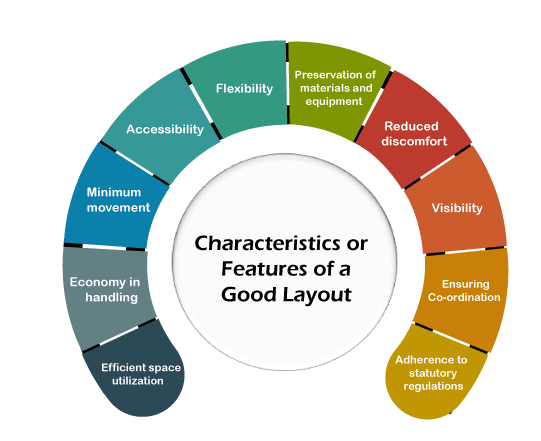
The following are the characteristics or features of a good layout: 1. Efficient Space UtilizationReal estate costs are constantly increasing. An optimal layout must use the available space in a compelling manner. There should be no waste of space at all. Equipment, service points, and staff must be arranged so that space is efficiently utilized. 2. Economy in HandlingWhen it comes to resources, work-in-progress, and finished stock, the layout must be cost-effective. Handling must be decreased by the ideal utilization of truck lifts, conveyors, chutes, and hoists. 3. Minimum MovementThe layout must be designed in such a way that equipment and people move as little as possible. Movements must be quite far. Indirect material handling would needlessly increase cost without adding any benefit. As a result, wherever possible, avoid using indirect handling. 4. AccessibilityThe facility of manufacturing, maintenance, and servicing must be effectively available with no prevention. There should be adequate space between equipment to accomplish this goal so that the raw materials, machines, and men can move unreservedly from one place to another. 5. FlexibilityManufacturing is a dynamic process. There is consistent advancement in sorts of products manufactures and in equipment, methods, and production process. Hence, the layout has to be designed in such a manner that it can adapt to changes. 6. Preservation of Materials and EquipmentThe layout must comprise safeguards against fire, theft, moisture, and general deterioration of equipment and materials. There should be sufficient and secure storage facilities. There should be a system in place to store flammable goods separately and safely. 7. Reduction DiscomfortThe layout should be created in such a way that the workers are as comfortable as possible. It should have adequate lighting and ventilation and limit the effects of heat, smells, noise, vibrations, and dust. 8. VisibilityWork must be organized so that there is no issue in oversight, organization, and control. Raw materials, work in progress and finished goods should all have designated storage areas that are always visible. This would lessen the issue of pilferage, stealing, etc. 9. Ensuring Co-ordinationA decent layout would have the option to coordinate all tasks. However, the format must be planned considering the inter-relationships among several departments, equipment, and personnel. As a result, it is critical to evaluate the entire picture of the organization when creating the layout. 10. Adherence to Statutory RegulationsThe layout must adhere to the guidelines of the Factories Act for the wellbeing, security, and welfare of employees. Adherence to the above guidelines would lessen mishaps, decrease absenteeism because of illness, resulting in increased productivity. Types of Layouts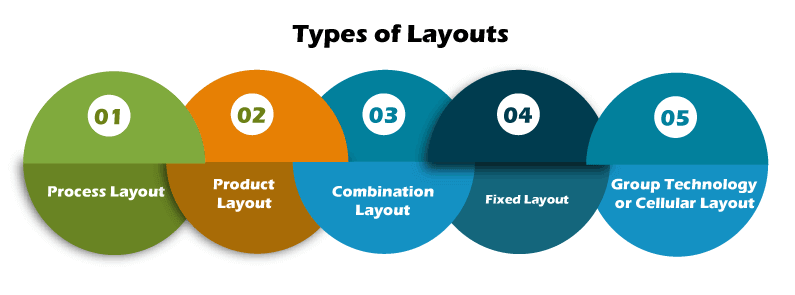
There are four basic types of layouts: 1. Process LayoutProcess layout means the layout which group resources based on the similar processes or functions. This type of layout can be found in companies that use intermittent processing systems. A process layout is used in contexts where many different items are produced in small quantities. Because there are so many different items are produced with distinct processing requirements, it is not viable to allocate an entire facility to each item. It is more effective to organize resources based on their function. The products are then shifted from one resource to the next according to their specific requirements. 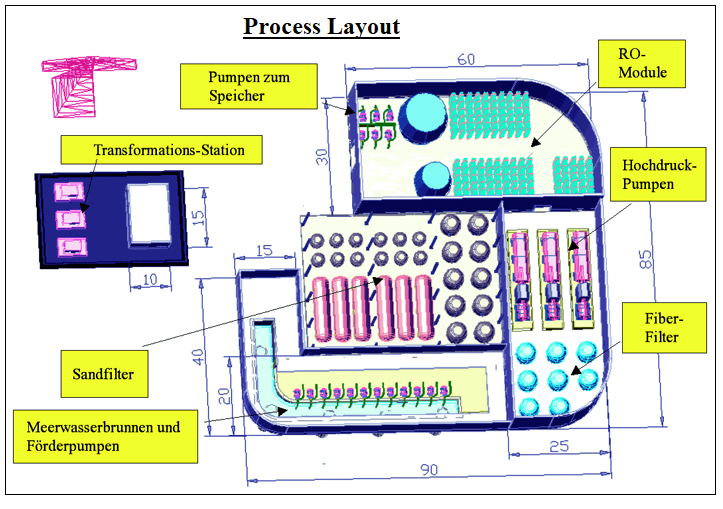
2. In process layout, the main challenge is to organize the resources to maximize efficiency and minimize waste of the movement. If the process layout is not appropriately designed, numerous items should be moved considerable distances, typically on a regular basis. This kind of movement adds nothing to the worth of the product and contributes. Advantages of Process LayoutThere are various advantages of process layout: 1. Overheads Expenses are Reduced Because of the low investment at the underlying level, the investment risk is reduced. Likewise, there is no duplication of machines in this layout. Besides, various machines can be worked and controlled by one operator because of the similarity of activities. In this way, per unit overhead cost will be reduced. 2. More Flexibility A single machine can conduct several similar operations in the process layout. So, in a machine breakdown situation, another machine in a similar department can do a similar operation, or even a comparable machine lies in another department that can do a similar function. As a result, this layout provides more flexibility in processing production operations. 3. Maximum Utilization of Machines The machine can be used to its full potential because a machine is not linked to any specific product in a layout during the process. 4. Low Investment in Equipment and Machines There are no sets of operating sequence in the process layout that the equipment and machines must pass through. As a result, products of various verities within the established standards can be developed using this layout, and no duplication of equipment is necessary for such a process. Hence, less capital is required because the machines' maximum potential is utilized. Disadvantages of Process LayoutThere are various disadvantages of process layout: 1. More Processing Time In process layout, the time required to finish a job will be longer because each project will flow between several departments. When the work has been collected from the preceding department, machine loading takes a long time. 2. Frequent Need for Inspection The same manufacturing department manages many items in the process layout. As a result, moving work to the next level of operation in another department, inspection is required on a regular basis. 3. Bigger Space at Floor Process layout takes up a significantly more prominent space on the floor. For machine installation and locating several departments. The full available floor area cannot be used because of the enormous size of the floor space. 4. Higher Material Handling Costs Material management costs are higher in-process layouts due to different day-to-day routines of various departments and longer distances to move jobs. 2. Product LayoutWhen all the processing equipment and machinery are positioned according to the product's sequence of operations, this type of layout is known as product layout. The main focus of product layout is the sequence of operations regarding the production or assembly needed for a product or some of its parts manufacturing and assembling. Product layout is typically advantageous for sectors that produce in large quantities or on a continuous basis, such as automobile assembling, cement manufacturing, and oil refining. 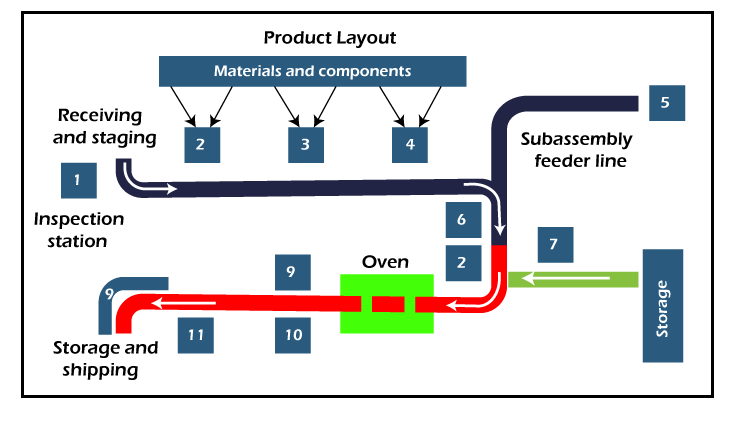
When it comes to product layout, if there is a significant production volume of one or more than one product, facilities can be aligned to ensure optimal material flow and reduce cost per unit. For this purpose, specialized machines are used to perform the desired jobs in a timely and reliable manner. However, it is not like process layout; product layout is not flexible because it is designed for developing or assembling a single product. We can see this kind of layout in flow shops where there is a lot of assembly repetition. To generate more standardized goods in high numbers, flow shops need repetitive and highly standardized operations. According to the product routing schedule, the resources in the product layout are arranged in a specific order. Through this sequential layout, the complete process is organized in a straight line. The flow of line can be divided again to ensure that workers are used efficiently throughout the operation. Line balancing is widely used to improve product layout efficiency. Line balancing is a method used to assign jobs to a different workstation so that the time requirements at each workstation are roughly equal. Advantages of Product LayoutThere are various advantages of the product layout. 1. Cost of Material Handling is Lesser In product layout, the machines are arranged based on the sequence of operations, so there is no forward and backward movement. As a result, material handling expenses and time are reduced. It also removes the transportation cost, which is associated with moving materials between machines. 2. Time-Saving The product layout aids in reducing the amount of time spent moving goods because materials can be transported using various automated equipment such as conveyor belts. This helps to save a substantial amount of time. 3. Use of Resources in Effective Way In product layout, we can effectively use the resources because product layout helps to reduce the movement of workers, eliminating waste, continuous manufacturing process, lowering do7.wn the work-in-process. 4. Control Over Production The product layout helps production control because of the continuous manufacturing process. Management may find it simple to plan operations, and they may take steps to ensure that the job is completed according to the plans. 5. Smooth Production Flow Another advantage of product layout is smooth production flow. The entire production process is incorporated into the product layout. As a result, there is no risk of production being halted at any point during the manufacturing process. Thus, this layout ensures that the production runs smoothly. 6. Lower Work-in-Progress In product layout, the production process is continuous and flexible; the work-in-progress is also reduced. Work-in-process needs less storage space and investment. 7. Utilization of Space in Optimum Way We can appropriately use the available space because of the sequences of machines. Also, if the space is limited, machines can be organized in a U shape to maximize efficiency. Disadvantages of Product LayoutThere are various disadvantages of product layout: 1. Difficulty in Expansion It's difficult to increase production beyond the capability of production lines. 2. The Extra Cost of Surplus Workers Workers that are skilled at working on specialized machines are inexperienced when it comes to operating other machines. So, if a worker assigned to a specific task is away for a few days, it has a negative impact on the entire workforce. In such circumstances, it may be necessary to hire additional staff and train them to work on various machines. 3. Monotony The product layout creates monotony because of the repetitive kind of work for workers. The worker has very little opportunity to demonstrate their abilities. 4. Costly Layout Product layout is viewed as an expensive layout because there may be duplication of machines of similar kinds needed for various production lines because of the machine arrangement based on the sequence operations. 3. Combination LayoutThe advantages of both kinds of layouts are combined in a process and product layout. A combination layout is possible when an item is manufactured in multiple types and sizes. The machinery is grouped in a process layout, but the process grouping is then ordered in a sequence to make a variety of goods of different types and sizes. 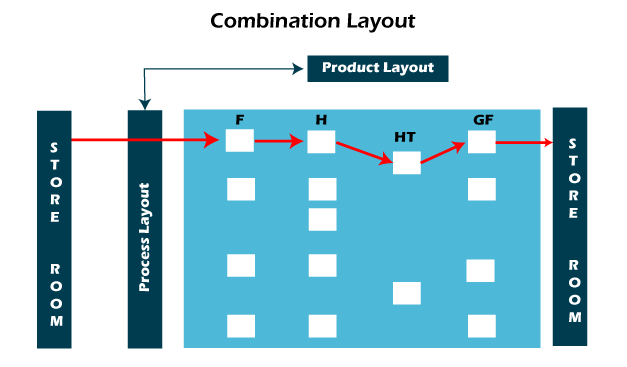
It is to be noted that the sequence of processes is consistent over a wide range of processes is consistent over a wide range of items and sizes. The following figure displays a mixed type of layout for manufacturing various sized gears. 4. Fixed LayoutThe fixed layout permits a product to maintain at a particular place, and the needed resources like manpower, machinery, material, equipment, etc. are transported to the product's location. In other words, the place of the main element or the product section remains fixed because of the larger size or substantial body. Additionally, the expense of moving or transportation costs will be lesser on account of moving assets when contrasted with the transportation cost associated with the movement of the product. 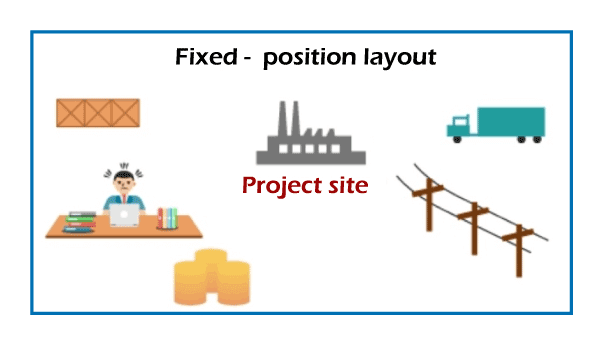
As a result, it is more advantageous to move the necessary tools, staff, hardware, and materials to the place where the product is gathered instead of shifting the product. For example, different products such as heavy ships, airplanes, projects related to construction are usually manufactured via a fixed-position layout. This layout is also often utilized in various on-site services, such as service related to housecleaning, landscaping, pest control, etc. The fixed-position arrangement is used by a variety of organizations that manufacture boilers and turbines. Transport to the construction site. Correspondingly, this layout is appropriate for hospitals, where patients are the primary fixed products, and doctors, medical personnel, medicines, and other necessary items are deployed for the patient. Advantages of Fixed Position LayoutThere are various advantages of fixed position layout:
Disadvantages of Fixed Position LayoutThere are various disadvantages of fixed position layout: 1. Work Schedule of Workers A plant, which has implemented a factory position layout, necessities to design the plan for getting work done for laborers in a cautious way, so every single one of them is allocated the necessary chance to deal with the specific phase of the production process. If there should be an occurrence of the non-availability of a specialist or the situation of the non-working limit of the laborer, at that point, it might moderate the speed of different phases of the process. This could cause the product's development time to lengthen, and the plant could lose money due to higher overhead costs. 2. Limited Workspace Limited workspace is one of the disadvantages of fixed-position layouts. Due to the number of workers necessary in various manufacturing steps, there may be a constraint on the workspace. 3. Cost of Equipment Another disadvantage of fixed-position layout is the equipment's cost. The product remains in a single area in a fixed position layout, and various tools, equipment, and machinery are essential to moving the product's location. As a result, transportation, maintenance, and equipment expenses are all extremely high. 4. Need Based Order of Material One of the drawbacks of utilizing a fixed-position layout is that hardware and materials should be moved when these are essential. Where hardware and materials can be stored and kept in a safe working environment until they're needed for the next step in the production process. 5. Group Technology or Cellular LayoutGroup technology or cellular technology is viewed as a strategy via which it is feasible to recognize and group comparable or related parts elaborate in the production process to take advantage of the inherent economy of flow production methods. 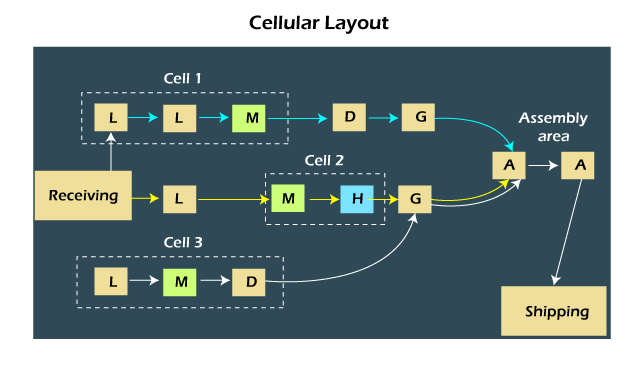
In other words, in group technology or cellular manufacturing layout, different machines are grouped based on the process requirements for a similar set of products or groups of comparable parts that require a comparable sort of processing. Groups that are formed in such a manner are named cells. In group technology or cellular layout, cells are formed by grouping various processes. This process incorporates the identification of parts having comparable qualities in the context of their design, example, shape, size, and function. Furthermore, qualities of a comparative process, for example, required processing type, sequence of processing, and the type of machinery to perform. In this type of layout, workers are provided cross-training to improve their ability to operate diverse equipment in a specific cell and be responsible for that cell's output. In a couple of cases, the formation of a cell depends on using specific equipment for creating pieces of a family without the need for actual equipment relocation into a physical cell. These cells are named virtual or nominal cells. An organization can avoid the hassle of altering its current arrangement by doing so. An automated variant of the cellular layout, i.e., a Flexible Manufacturing System (FMS) is also available. A system that uses this technology deals with the control of transferring parts to various processes. A system that uses this technology deals with the control of transferring part to various processes. This allows producers to acquire a couple of benefits product layouts while still maintaining the manufacturing flexibility associated with small batches. For instance, there is a manufacturing unit that produces 10,000 parts. These parts may be grouped into one of 50/60 families of parts. Every family has a similar kind sort of design and qualities of manufacturing. As a result, all members of a family will be processed in the same way. This aids in the production of manufacturing efficiencies. Advantages of Group Technology or Cellular LayoutThe following are the advantages of a group or cellular layout. 1. Enhances Motivation Different personnel are provided cross-training to manage all machines in their cell in group technology or cellular layout, which helps to increase their motivation by minimizing monotony. This improves job ownership and autonomy because workers are accountable for the production of their cells. 2. Increase Flexibility Group layout or cellular allows for the production of small batches, which increases flexibility to some level. 3. Reduced Cost Group technology or cellular layout contains a number of benefits such as faster processing time, reduced material handling time, less inventory in work-in-process, and less set-up time. This is beneficial in terms of cost-cutting.
Next TopicWeb Servers
|
 For Videos Join Our Youtube Channel: Join Now
For Videos Join Our Youtube Channel: Join Now
Feedback
- Send your Feedback to [email protected]
Help Others, Please Share










